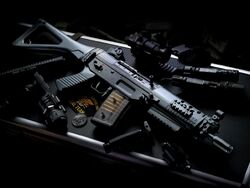The SB-30, commonly known as Tactical Assault Carbine, or TAC, was a military-issued blaster carbine developed to replace its UC-46 Carbine predecessor as the standard assault weapon in the Republic military. The weapon was designed as an all-purpose carbine that would have seen use in the Republic's ground and special forces.
Its initial design was framed around that of its predecessor, it kept the relative shape and characteristics of its ancestor. The stock of the weapon, however, was altered slightly and hollowed out to reduce weight. The weapon became known for its reliability in all fields of combat and its durability. The carbine specialized in close-quarter, urban warfare, but had the ability to perform in long range, open environments as well. The carbine was eventually replaced in favor of the smaller and more efficient DC-15S blaster carbine and its rifle variant.
History
Conception
The SB-30 was one of several weapons designs submitted in a BlasTech-sponsored competition circa 23 BBY. The firm created the competition because it hoped that a suitable all-purpose firearm could be found without the need for its Research and Development Department which was taxed preparing other items, such as the Strategic Utility Blaster and the Rail-Cannon. Thompson Kalash, a Human from Balmorra, submitted an entry in the Carbine entry field. Thompson was a small arms enthusiast that studied prior designs, like the UC-46, and utilized many of their more successful design features and cobbled them into a compact carbine.
The weapon used the obstruction-less durasteel sights of the the UC-46 as a basis for his design. The weapon also featured a hollowed out stock to reduce the weight of the carbine. Kalash also adapted the shortened barrel to successfully carry a slugthrower masterkey, a flamespewer, or a grenade launcher as an underslung attachment. Before the SB-30, underslung attachments were impractical or unusable on carbine blasters.
The design won the contest outright in the Carbine field because of its versatility and reliability.
Further field tests

The SB-30 Tactical Assault Carbine with extended clips.
BlasTech commissioned several experimental SB-1s for additional testing. The weapon performed well against its competitors in the carbine and assault rifle class with shortcomings in recoil and maintenance. The added punch of blue coherent light, the most powerful form of light cell, caused the weapon to suffer from light recoil. Mixed with the light stock, the weapon had an inclination to kick up. The carbine also had problems with its seals and maintenance when faced with cold or corrosive conditions seen on Hoth or Tatooine. The blaster would lock up or cease to work when it spent significant time in those conditions.
BlasTech phased out production of other experimental rifles and carbines, all of which had at least one major flaw during testing, and dedicated itself to correcting the minor errors on the SB-30 to prepare it for full-production.
Production
The SB-30, designated so because it was the thirtieth entry in the competition, went into production with a target number of twelve million units over a five year production run. The number was modest for the model because the Republic lacked an official army so the units were to be sold exclusively to sponsored security organizations and to the Judicial Forces and RDSF. This accounted for the low initial production estimates. The weapon's initial price tag of 6,300 credits was considered inexpensive because the DL-3, a heavy pistol that predated the carbine by three millennia, had a price of 3,000 credits. The price would drop considerably come its release three years later. Batches would be churned out yearly at a consistent rate until 20 BBY.
Design
Thompson Kalash designed the weapon for maneuverability and functionality. The SB-30 accomplished that with its compact and unobtrusive construction. Although the weapon was relatively lightweight without any adjustments, Kalash hollowed out the butt stock to provide even more relief to the user. The weight reduction made the weapon easier to handle and reduced arm fatigue for long operations. Because it was compact, the weapon was classified as a carbine and was required to be able to handle the close-quarters combat associated with that classification. The carbine used plain, unobstructed durasteel sights. Contrary to its predecessor, it did not have picatinny rails, durasteel brackets that ran the length of the barrel between the primary and secondary sights, and required an alternative way to attach optics and light assists.
Characteristic of carbines, it had a lower rate of fire, point of impact power and range when compared to the bigger and heavier rifle class.
Equipment

The SB-30 with most of its attachments.
The SB-30 possessed the capability to incorporate attachments. It was unique among carbines in that it could have utilized underslung, beneath the barrel, attachments such as a masterkey, flamespewer or grenade launcher. Typically carbine weapons were unable to use underslung attachments because they required a longer barrel, which carbines, by definition, could not have had.
Aside from the underslung attachments, BlasTech offered the rare silencer, or suppressor, as an attachment. Reflex, ACOG, low-powered, variable and laser sights were also common. These sights replaced the durasteel sights for aiming. Visibility assisting flashlights were also offered as an extra. Extended magazines were available for the carbine which increased the charges from the standard thirty charges to one hundred.
Strengths and weaknesses
Strengths
SB-30 was similar to its cousins in the carbine class in many ways. It had the advantage of being a compact lightweight alternative to the rifle in urban and close-quarter conflicts. The SB could have been used effectively during long engagements because of its light weight and generous clip capacity. The blaster carbine was compact, did not restrict movement or mobility much and excelled in room clearance and other roles that required quick reaction in close-quarters. The carbine also fared better at long range when compared to its smaller counterpart, the blaster pistol, and had a faster rate of fire. It was very versatile and could complete tasks that the rifle and the pistol were not able to do. Its versatility extended to its firing capabilities. The blaster had selective fire settings that had settings for single-shot, three round burst or fully automatic fire. The carbine had the potential to be an effective weapon at range, nevertheless, it was rarely employed in that discipline.
The SB-30 could have utilized the grenade launcher and other under-barrel attachments. Maintenance was moderately low because of its compact construction and simplicity. That allowed fewer moving parts and substances and fewer crevasses for dirt and other particles to get into and interfere with operation. The weapon had a fairly long working lifespan. It was estimated at fifty standard years without maintenance and over five hundred with maintenance and diligent use. BlasTech did not make estimates for mint and rarely-used weapons.
Weaknesses
It was considered an all-purpose weapon when it came to the disciplines of combat and was routinely used in all-forms of combat. This meant the weapon was adequate at most disciplines, but did not excel. The weapon was effective in nearly all ranges of combat, but suffered when faced with the extremes. It did not fare well in extreme close range like a lightsaber would have and its performance would drop off at extreme long range. Long ranges were more suitable for the rifle or sniper rifle classes and was a rare weapon for the designated marksman to use. Its effective range was the mid-range sector of fifty to four hundred meters. The recoil and lack of power prevented it from being suitable for long range–a common trait of carbines– and the size and behavior of the weapon made it unwieldy from arm length in.
The carbine had a lower rate of fire and weaker power than its bigger competitors, the rifle. The light back end promoted higher recoil, a hindrance at range, which was amplified if the butt stock was removed. The slugthrowers and blaster pistols were better suited for close combat than the SB-30, but the SB was effective in the right hands. As usual with blaster weapons, the gun had problems with noise and muzzle flash. The carbine did come with a suppressor, but flash and noise was still noticeable and the use of such an attachment was uncommon especially when it was proven to detrimentally affect the speed of the propellant and point of impact power.
Behind the scenes
The imagery used for the SB-30 was based on the SG-552 Commando. This article was created by I'm the Chosen One. TAC was the informal name for the carbine until a more suitable alpha-numeric name, eventually SB–30, could be created. The article was voted "Best Technology" in the Seventh Wiki Awards.
Fellow Star Wars Fanon user Goodwood modified the official image of the SB-30 with a new clip, barrel and other tweaks. As of now, that image is the official image of the blaster, the others feature the blaster with extended clips.
